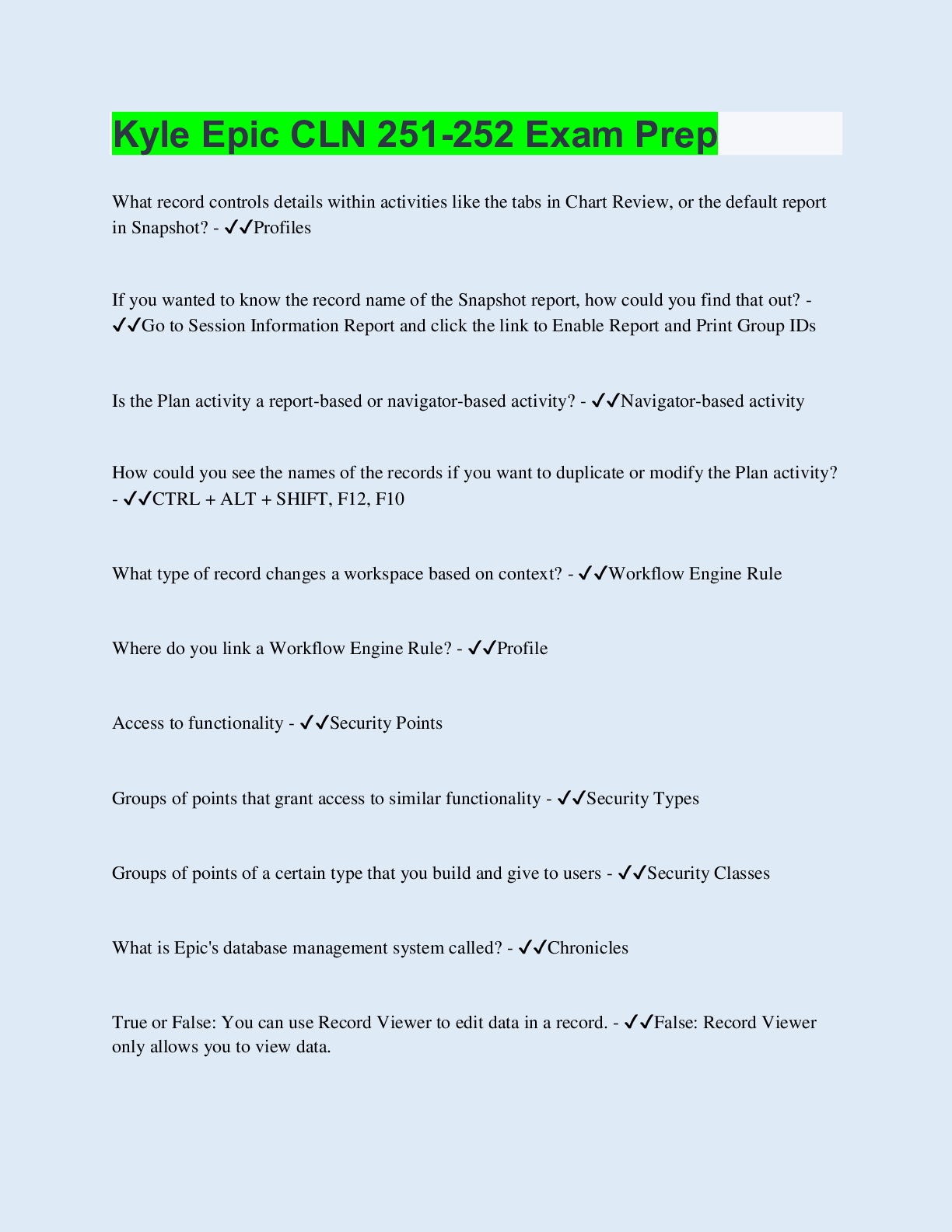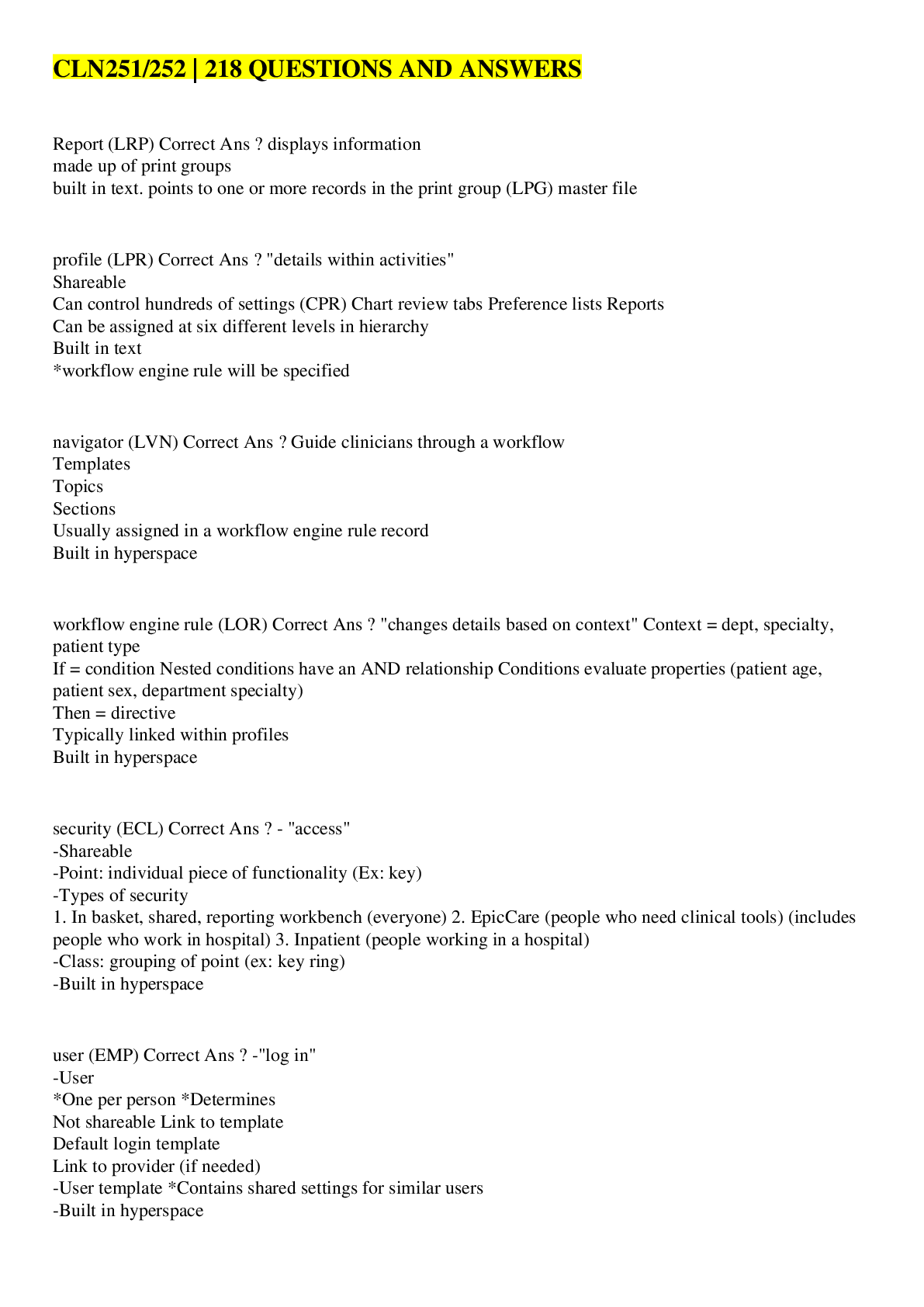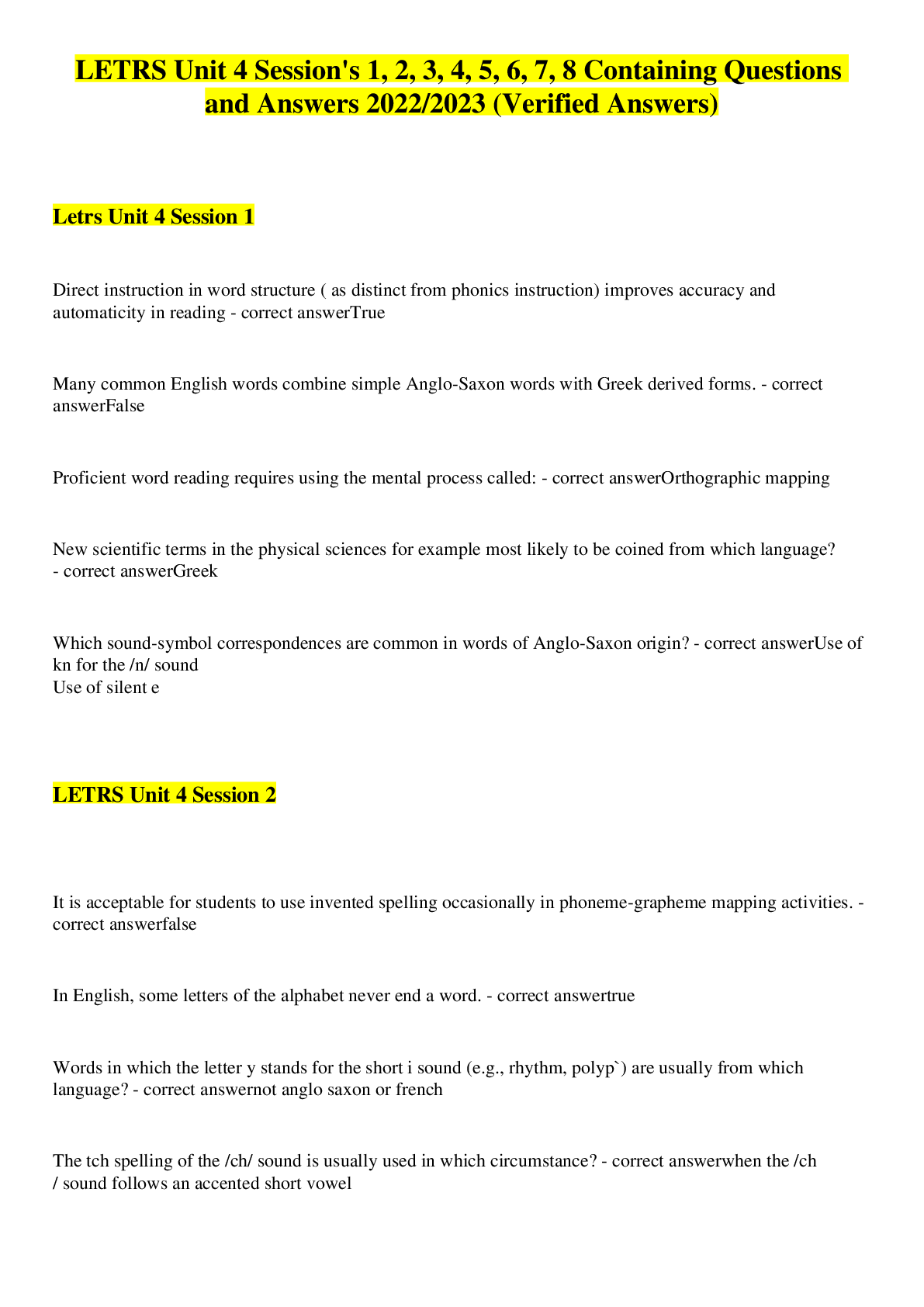Biology > EXAM > BIOD 151 FINAL EXAM A&P 1 (GRADED A) Questions and Answer elaborations | Most Tested Questions | 100 (All)
BIOD 151 FINAL EXAM A&P 1 (GRADED A) Questions and Answer elaborations | Most Tested Questions | 100% Guaranteed PASS
Document Content and Description Below
BIOD 151 FINAL EXAM A&P 1 List two organs contained in the abdominal cavity. Your Answer: small intestine and large intestine The abdominal cavity contains the stomach, intestines, spleen and... liver True or False? a. The purpose of cellular respiration is to produce ADP. (T or F) b. Peripheral proteins are found on the outer surface of a cell membrane. (T or F) c. Exocytosis is the process that occurs to bring biomacromolecules inside the cell. (T or F) d. Receptor-mediated endocytosis uses a signaling molecule from another cell, binding to the cell membrane to bring about changes within the cell proteins. (T or F) e. Endocytosis is a passive process. It does not require cellular energy expenditure.(T or F) Your Answer: a. False b. True c. False d. True e. False a. False- (ATP is produced, not ADP) b. True c. False- (This process is called endocytosis) d. True e. False- (Endocytosis is an active process and requires cellular energy) Note: Essay answers must clearly be in your own words. In your own words, discuss Tay-Sachs disease. What organelle within the cell is impacted? What are the symptoms of the disease and why do they occur? Your Answer: Tay-Sachs disease impacts the lysosome of the cell. This leads to a toxic buildup of toxins in the brain. This can lead to disability and death. (1) Lysosomes (2) buildup of toxic lipids inside the cell (biomacromolecules) (3) disability and death In the genetic disease known as Tay-Sachs, one of the normally present digestive enzymes inside lysosomes is lacking. Thus, a toxic lipid in the brain cells cannot be broken down. The resulting buildup of lipids in these cells can cause intellectual disability and death. Note: Essay answers must clearly be in your own words. You are observing two cells under the microscope. They are the same type of eukaryotic cell but one appears much larger. Based on appearance alone, which one would you expect to be carrying out respiration at a more active rate, the larger or smaller cell? Explain why. Your Answer: The smaller cell would carry out respiration at a more active rate. This is because of the increased surface area compared to larger cells. The smaller cell. Cells need to remain relatively small because as a cell expands the amount of surface area relative to the volume of the cell decreases. The smaller cell is more active because relative to its volume, its surface area is larger than a bigger cell. With a larger surface area (relative to its volume) this allows the metabolic processes to occur faster. Note: Essay answers must clearly be in your own words. Explain what happens to the soft palate during swallowing. Why? Your Answer: During swallowing, the soft palate in blocked by the tongue. This prevents choking on food or liquids. The upward movement of the soft palate prevents food or liquid from entering the nasal passages during swallowing. Air and food pass in which one of the following areas: Trachea Nasopharynx Oropharynx Alveoli Label the following five items from the diagram: Label B- Label D- Label E- Label F- Label G- Your Answer: B- oral cavity D- epiglottis E- Glottis F- trachea G- esophagus Label B- Oral Cavity Label D- Epiglottis Label E- Glottis Label F- Trachea Label G- Esophagus From widest to narrowest, the branches of the bronchial tree are: Primary bronchi, secondary bronchi, tertiary bronchi, bronchioles Bronchioles, primary bronchi, secondary bronchi, tertiary bronchi Tertiary bronchi, secondary bronchi, primary bronchi, bronchioles Secondary bronchi, tertiary bronchi, primary bronchi, bronchioles Explain why someone who has hypergastrinemia (excessive secretion of gastrin) might develop gastric/stomach ulcers. Your Answer: Someone who has hypergastrinemia may develop stomach ulcers because of the increased gastrin, this can irritate the stomach lining which would leade to ulcers. Gastrin stimulates the secretions of pepsinogens and hydrochloric acid. Excess amounts would lead to erosion of the stomach lining. Look carefully at the diagram below. Label the following 5 organs of the digestive system. To receive credit for the intestines you must label the specific region. 3: 4: 7: 9: 10: Your Answer: 3. stomach 4. gall bladder 7. large intestine 9. appendix 10. anus 3: Stomach 4: Gallbladder 7: Jejunum (not small intestine) 9: Appendix (not large intestine) 10: Rectum (not large intestine) Question 11 6.67 / 10 pts Note: Essay answers must clearly be in your own words. Answer the following essay question: Describe parietal cells and chief cells: name their location, secretions and purposes. Your Answer: Parietal cells secrete HCL and have a pH of 1.3-3.5. This acidic pH of these cells kills off bacteria that is ingested along with food. Chief cells secrete pepsinogen. HCL converts inactive pepsinogen to active pepsin. The parietal cells (located in the wall of the stomach body) secrete hydrochloric acid, generating a pH of 1.3-3.5. This very acidic pH kills many of the bacteria ingested along with food. In addition, the low pH stops the activity of salivary amylase. The secretion of hydrochloric acid is essential in the activation of pepsin. Chief cells: secrete pepsinogen. Pepsinogen (a pre-enzyme) is secreted by the chief cells in the stomach. Hydrochloric acid converts the inactive pepsinogen (secreted by the chief cells) into the active enzyme pepsin which begins the breakdown of proteins. name their location Label the following bones of the skeleton from the figure below: 1: 3: 5: 7: 8: Your Answer: 1. frontal 3. maxilla 5. vomer 7. maxilla 8. mandible 1: Frontal bone/frontal sinuses 3: Maxilla 5: Vomer 7: Maxilla 8: Mandible Label the bones in the figure below: A: B: C: D: E: Your Answer: A. pisiform B. hamate C. capitate D. trapezoid E. trapezium A: Pisiform B: Hamate C: Capitate D: Trapezoid E: Trapezium A patient has a diagnosis of osteoporosis. (1) In your own words, describe this diagnosis and (2) What type of bone cell would they be lacking? Explain your answer. Your Answer: Osteoporosis is a bone disease in which bone tissue degenerates which causes weak bones. This can lead to fractures. They would be lacking osteoblasts which would be decreased and would inhibit bone repair. (1) Osteoporosis is a bone tissue disease. When bone tissue degenerates faster than is replaced, the bones become weak. Brittle bones cause increased pain and are more likely to fracture. (2) They would have decreased osteoblasts which are responsible for bone repair. The bone repair would be unable to keep up with the ongoing breakdown of bone which is done by the work of osteoblasts. Label the following five muscles: B: C: E: G: J: Your Answer: B. temporalis C. orbicularis oculi E. zygomaticus major G. buccinator J. depressor labii inferioris B: Temporalis C: Orbicularis oculi E: Zygomaticus major G: Buccinator J: Depressor labii inferioris When extensor digitorum contracts, what action(s) occurs? A. Elbow extension B. Wrist extension C. Extension of digit 1 D. Extension of digits 2-5 E. A&C F. B&D Would you expect a male to have estrogen in their bloodstream? Explain why or why not. Your Answer: Yes, both males and females have all of the sex hormones. Adrenal gland is responsible for for the opposite sexes hormones. (1) Yes. Both male and female bodies produce “all” the sex hormones. However, the ratios are different. (2) The adrenal glands are largely responsible for producing this “opposite” hormone that the testis would not. List the hormone(s) that best describes the statement below: I lower the level of calcium in the blood by depositing calcium into bone. Your Answer: calcitonin Calcitonin List the hormone(s) that best describes the statement below: I am secreted by the beta cells of the pancreas. Your Answer: Parathyroid hormone Insulin Aldosterone is involved in the regulation of sodium and potassium in the body. Explain how too much aldosterone could contribute to high blood pressure. Your Answer: Too much aldosterone could contribute to high blood pressure because this would cause sodium levels to increase in the body while potassium levels decreased. Increased sodium leads to high blood pressure. Lack of potassium could lead to cramping in thr body which would be from non regulation of aldosterone. Aldosterone’s primary target organ is the kidney, where it promotes renal absorption of sodium and renal excretion of potassium. The blood sodium level is particularly important to the maintenance of blood pressure. Too much sodium causes retention of fluid and increases blood pressure. Therefore, too much aldosterone will cause increased and potentially high blood pressure. A- Identify the sensory cell receptor highlighted in blue, below, also indicated by the arrow. B- What sensory information is detected by this type of receptor? Your Answer: pacinian corpuscles- mechanoreceptor A) Pacinian corpuscle B) Detects pressure (mechanoreceptor) Match the cell with its single best description, using each description only once. Keratinocytes Fibroblasts Melanocytes Langerhans cells Other Incorrect Match Options: • Detects pain • Detects light touch What is the name and function of the structure below? (Highlighted in blue, also indicated by the arrow) Your Answer: Sebaceous gland- produces oil in which to prevent hair and skin from drying out. Sebaceous gland (oil gland) produces oil (sebum) to protect the skin and hair from drying. Quiz Score: 134.17 out of 140 [Show More]
Last updated: 1 year ago
Preview 1 out of 16 pages
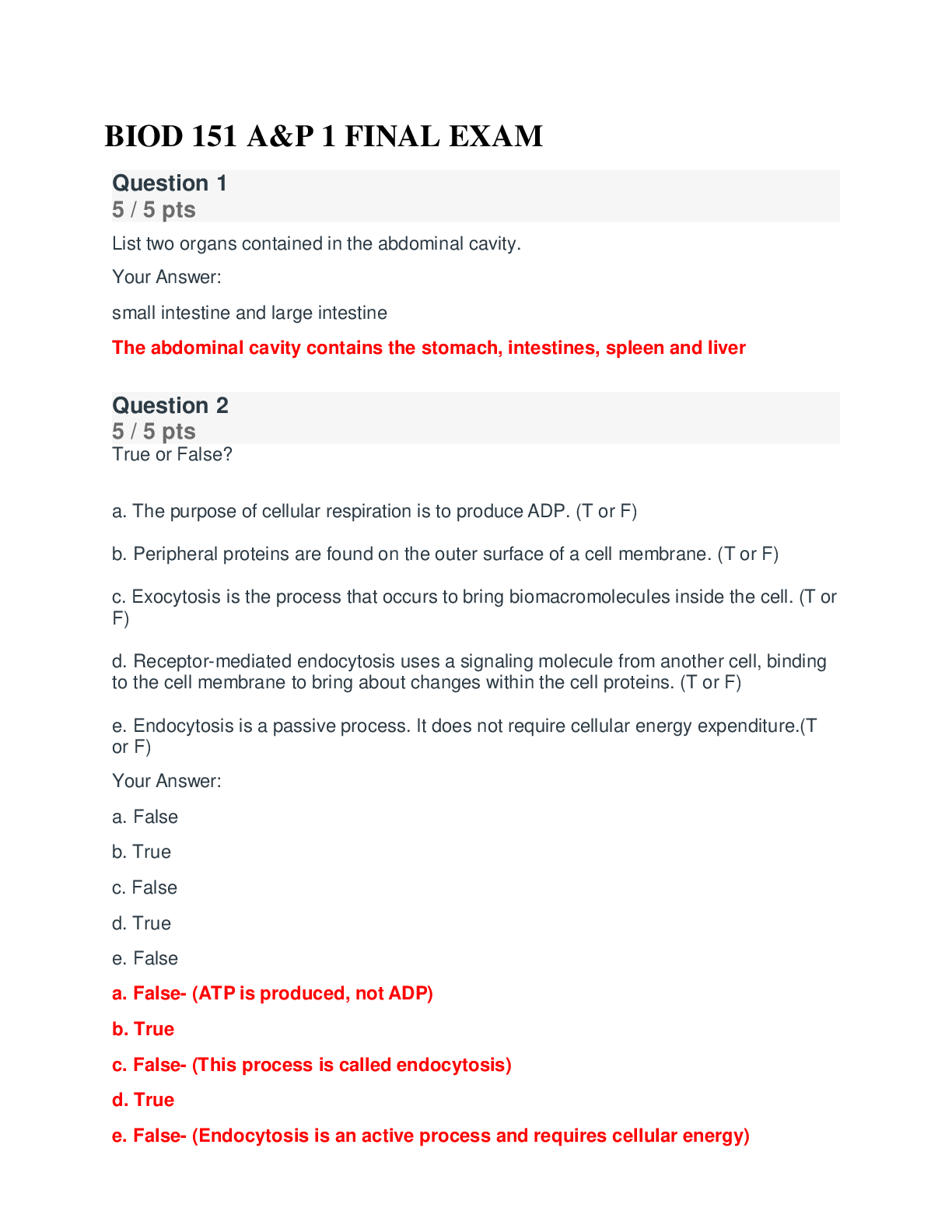
Reviews( 0 )
Document information
Connected school, study & course
About the document
Uploaded On
May 10, 2022
Number of pages
16
Written in
Additional information
This document has been written for:
Uploaded
May 10, 2022
Downloads
0
Views
33




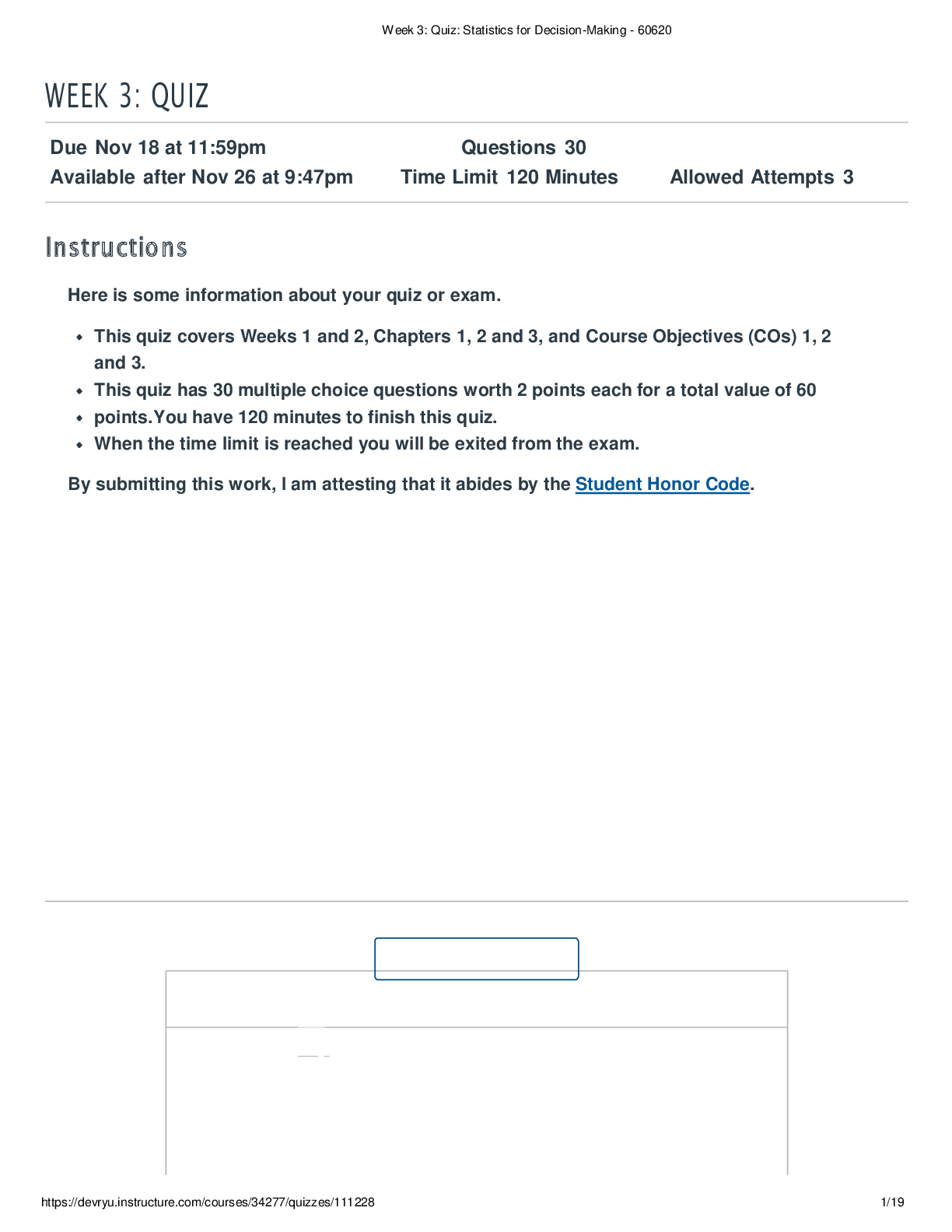

.png)












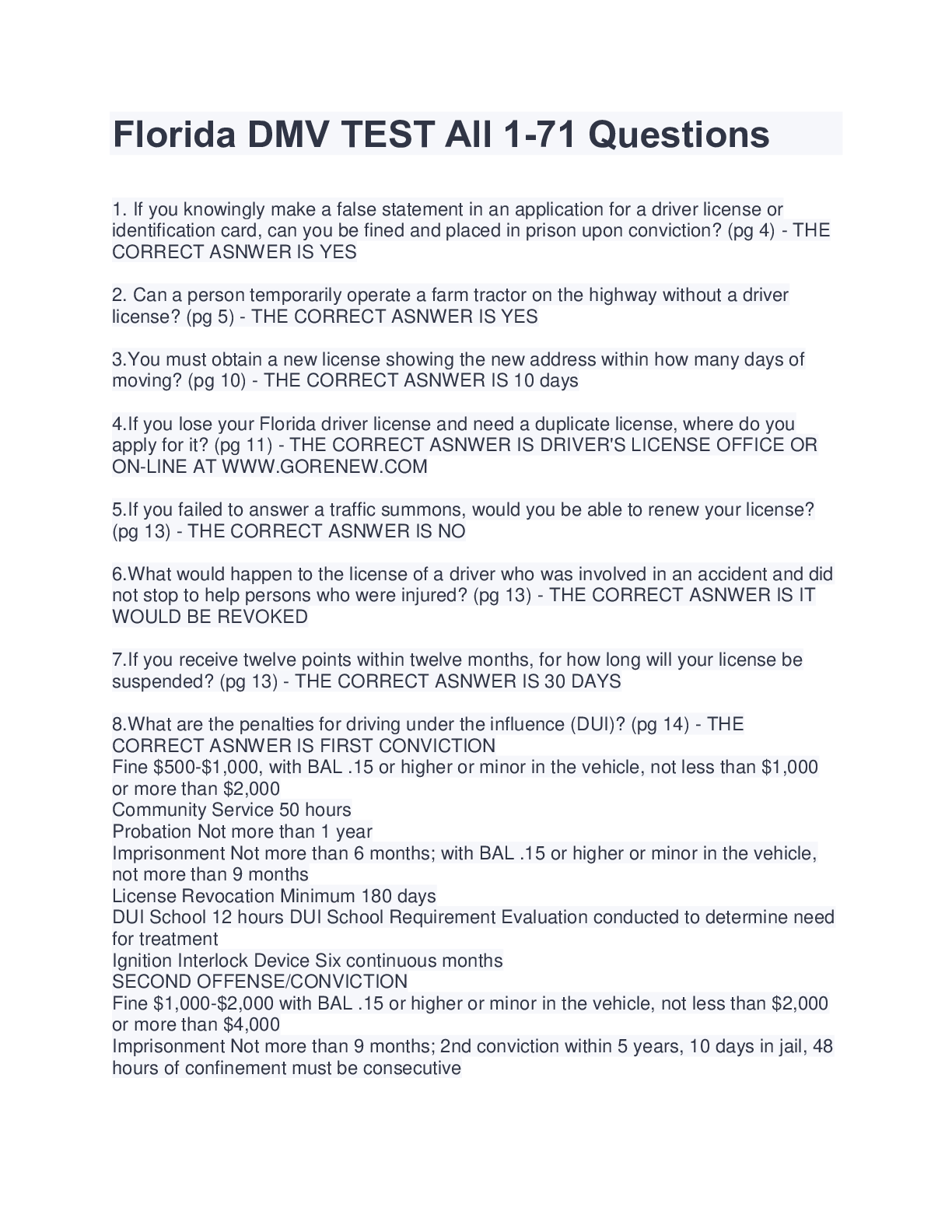
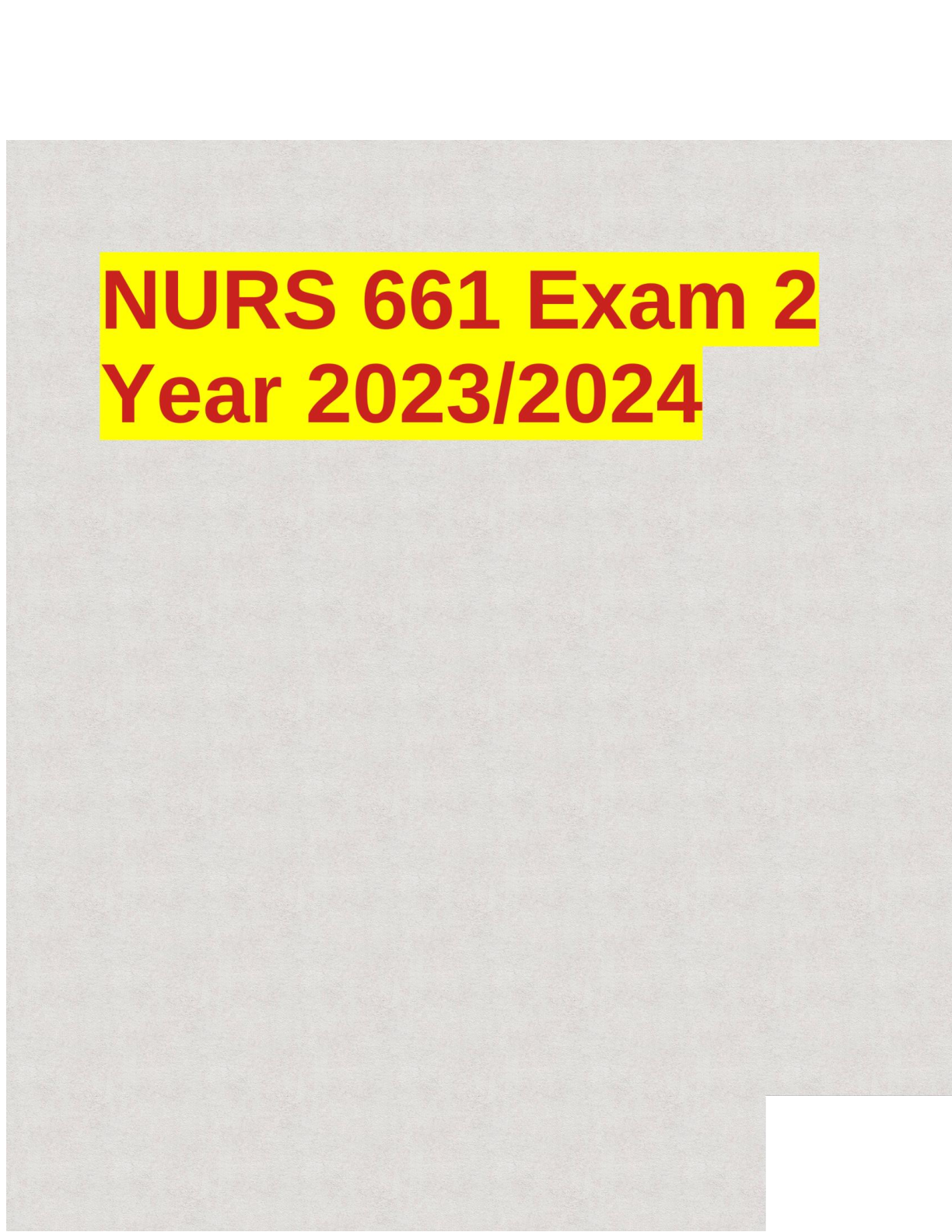

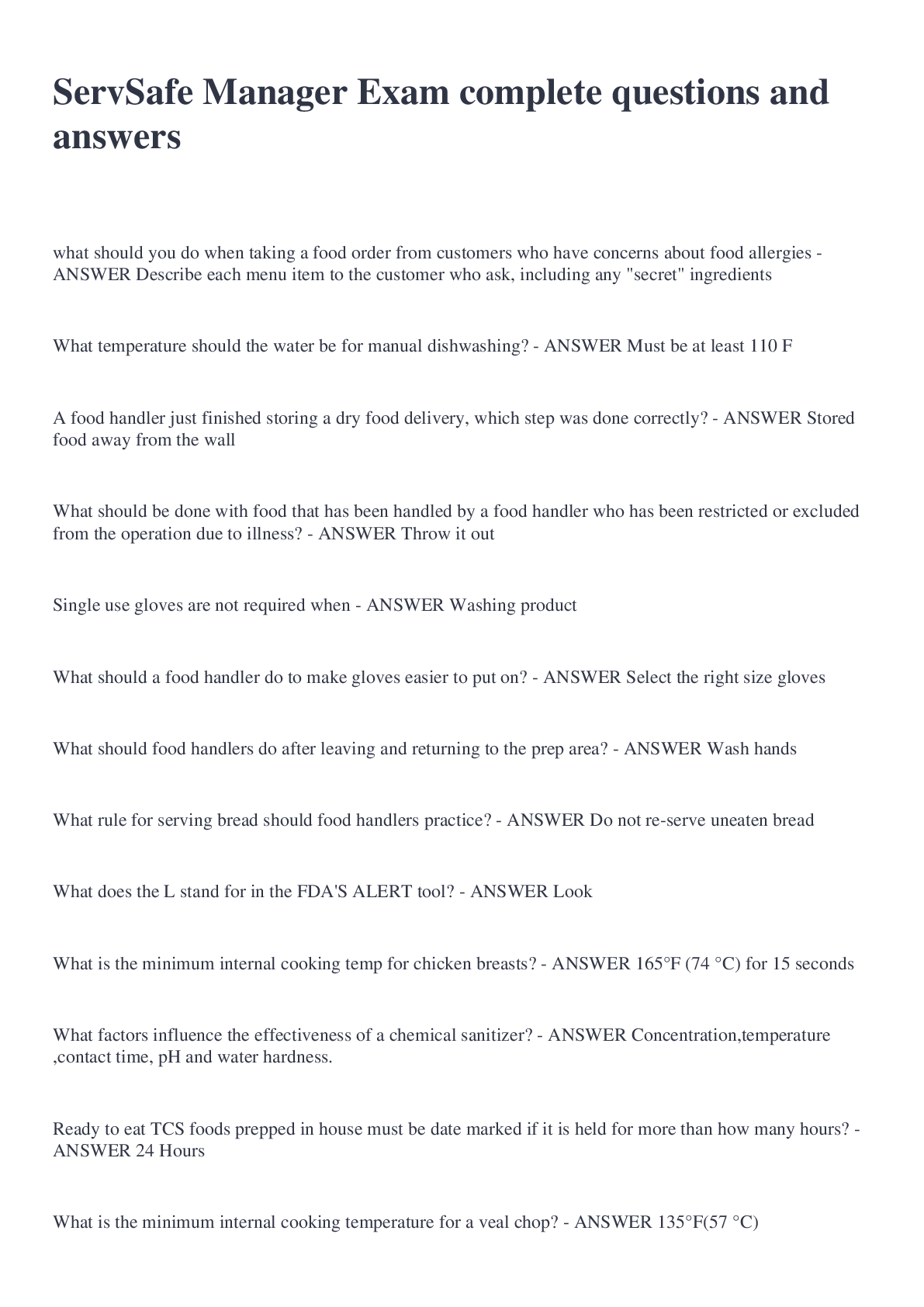

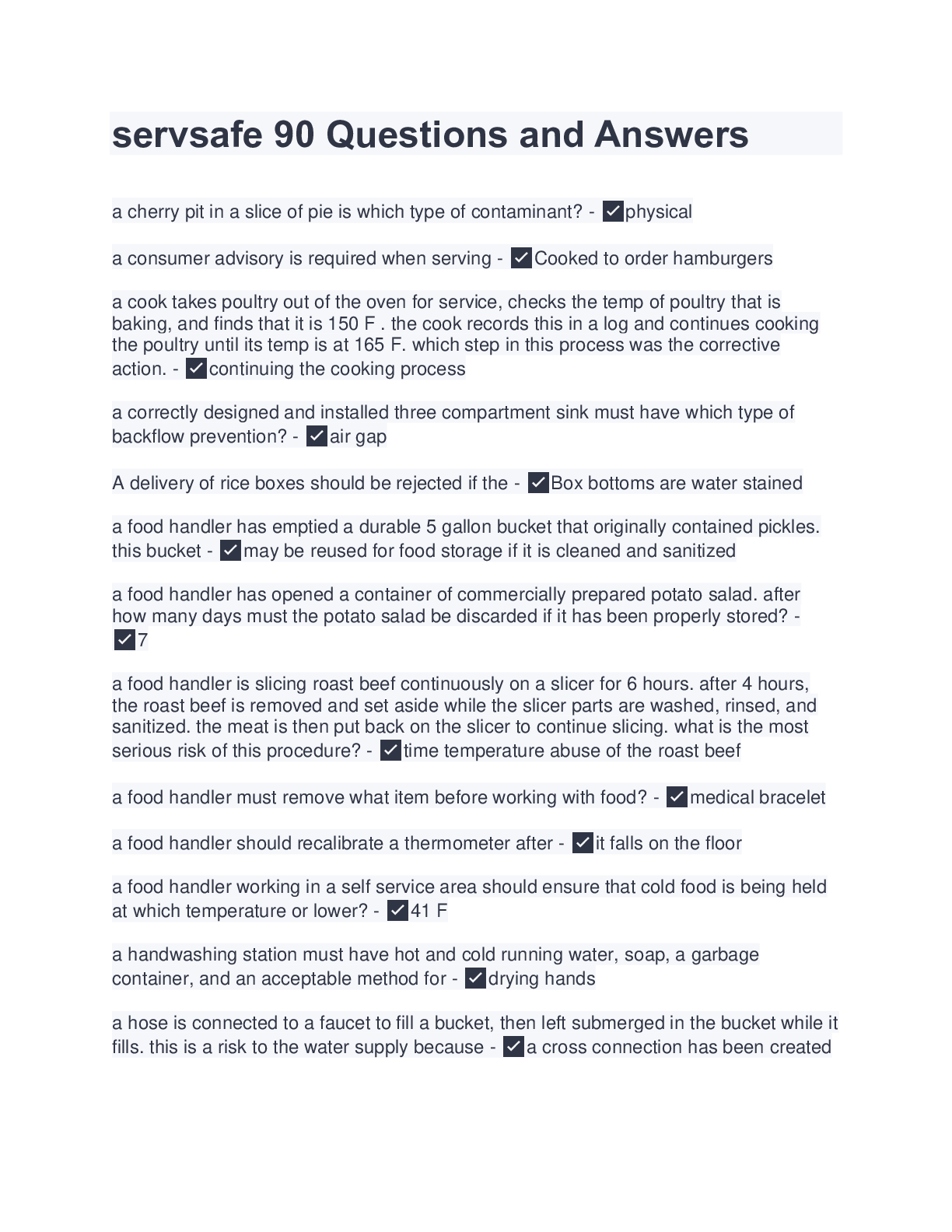
.png)


